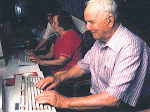Mosterøy, Norway - Having emerged triumphantly from the historic Utstein Abbey on the Norwegian island of Mosterøy early this morning, Chiropractor Frank Grimes announced to a hushed crowd of thousands an updated list of potential causes of the vertebral subluxation.
 |
| According to a recent study near Harvard, 30% of vertebral subluxations in women occur when a child steps on a sidewalk crack or line |
"No longer will chiropractors be forced to clumsily fumble around in the dark," Dr. Grimes explained. "We may now call upon the shining light of expert consensus to illuminate the path to better health for all of our patients!"
Not since the 1996 meeting of the Association of Chiropractic Colleges, when the definition of the vertebral subluxation was solidified, and a golden age of manipulation was ushered in, has there been such a huge leap forward in the field. Now, in addition to knowing that a vertebral subluxation is a complex of functional and/or structural and/or pathological articular changes that compromise neural integrity and may influence organ system and general health, chiropractors around the world will have an improved framework for what causes them. They hope that this newfound knowledge will lead to improved subluxation prevention and, most importantly, in the saving of countless lives.
The following is a list of the categories of potential causes of the vertebral subluxation complex, and some common examples as determined by almost 100 chiropractors representing the European Society of Chiropractry, the European Academy of Chiropractology, the PanAsian Society for Intensive Chiropractic Medicine, the American Academy of Chiropractic Engineers, the International Union of Concerned Chiropractors, the World Chiropractic League All-Stars, and several additional related societies including, but not limited to, the Eastern Michigan Chiropractic Dinner Club, the Southern Chiropractic Dentists of America Society, Chiropractic Anonymous, and local chiropractor Ulf Peterson who hosted the assembled experts at his house for a traditional Norwegian meal of boiled sheep's head and glogg:
T(rauma)1. Major physical trauma - Falling down stairs, being hit by a truck, being vaginally delivered
T2. Moderate physical trauma - Sneezing, watching a tennis or ping pong match
T3. Mild physical trauma - Eating, breathing, a light breeze
C(hemical)1. Major chemical trauma - Smoking, alcohol, pollution, pharmaceuticals
C2. Moderate chemical trauma - Nutritional deficiencies, caffeine, processed food, food allergies
C3. Mild chemical trauma - Heartburn, hot tubs set to > 90F, offensive odors
E(motional)1. Major emotional trauma - Divorce, death of a spouse or child, verbal abuse such as from an employer, psychological abuse such as when a new acquaintance beings to slowly adopt your mannerisms and style of dress in a sadistic attempt to replace you in your circle of friends
E2. Moderate emotional trauma - Louse noises such as gunfire or accidentally knocking over a lamp or stepping on a squeaky dog toy when trying to sneak out of the apartment without waking up your roomate who we all know is kind of a jerk and your friends don't like him
E3. Mild emotional trauma - Quieter noises like soothing whispers from a lover or the beating wings of a hummingbird in a nearby English garden, guild such as that associated with forgetting to put the toilet seat down or to put gas in the car when you were the last person to use it and it was practically running on fumes
Miscellaneous - Gypsy curses, when your child steps on a crack or a line, spontaneous human subluxation

No comments:
Post a Comment